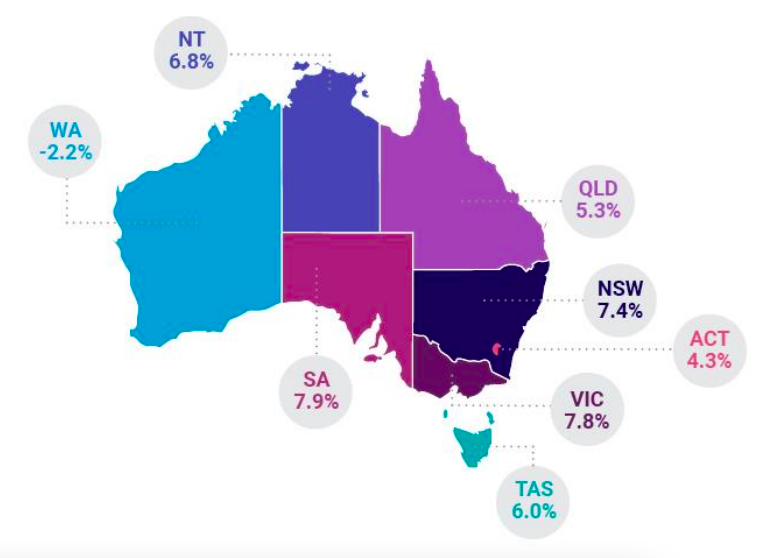Australia’s handling of the COVID-19 crisis is yielding positive results with business confidence rising: three in five companies (60.6%) believe the economy is headed for ‘good times’ over the coming year. The optimism comes from concerted efforts in the public and private sectors in keeping case counts low, analysis from research firm Roy Morgan suggests.
The country’s business confidence score jumped to 120.8 in February, reflecting a 16.2-point increase from a year ago. The outlook will likely reshape the investment landscape in the next 12 months – more than half of companies surveyed (55.5%) said the period ahead represents a good time to invest in business growth, the firm said.
Recruitment advertisements increasing
Recruitment advertisements are increasing, with SEEK reporting 12.4% year-on-year growth (the fourth consecutive month of y/y job ad growth) and 4.1% month-on-month growth. For the first time since the pandemic began, every state and territory saw year-on-year job ad growth and all states and territories saw a month-on-month increase in job ads, except Western Australia, which had a small drop of 2.2%. The top three industries contributing to year-on-year growth were Trades & Services, Hospitality & Tourism and Healthcare & Medical.
Kendra Banks, Managing Director, SEEK ANZ, states: “It’s close to 12 months since COVID-19 severely impacted the employment market, and we are pleased to observe continued improvement with the healthiest year-on-year job ad growth since the pandemic began. In February, there was year-on-year growth of 12.4% and month-on-month growth of 4.1%.
“For the first time since before the pandemic, all states and territories saw year-on-year growth in job ads posted on seek.com.au. New South Wales and ACT were the only two states, before last month, not to have returned to pre-COVID levels. In February, NSW saw an increase of 3.6% y/y, and ACT was 5.0% higher.”
Banks continues: “Professional Services is the only sector to still be showing a y/y decline, however, 10.1% is the smallest gap we have seen and is being more than made up for by the other sectors. Professional Services roles tend to be the more office-based corporate roles that are based in a CBD.”

“Australia’s speedy closing of borders, national and state lockdowns in response to outbreaks, large-scale government financial assistance and the general willingness of Australians to play their own role in bringing COVID-19 under control have all played a major role in the fact that the country emerged from 2020 in better shape than could have been imagined nine months earlier,” said Roy Morgan CEO Michele Levine.
However, even as the Australian economy appears to be “firing on most cylinders,” the large hole in the federal budget – resulting from increased fiscal spending – shows the economic toll of the crisis. “Having forecast a $6.1bn surplus for 2020-21, the federal government revised its position to an expected $213.7bn deficit,” Levine said.
“On an individual level, it is a tale told in two parts,” the CEO said. Millions of households that received government aid purportedly began the year “better off” than they were before the pandemic. However, 1.93 million people remained out of work in February, with the 18-24 age group the most heavily affected.
“A further 1.14 million under-employed people had some work but wanted or needed more. This is a total of 3.07 million Australians or 21.0% of the workforce. It is more than 900,000 higher than the number who were either unemployed or under-employed in March 2020, before the nationwide lockdown,” Levine said.
As Australia pushes ahead with its vaccination drive, business outlook will likely improve. However, Levine cautions against being overly optimistic. “We expect the vaccination rollout to boost consumer confidence in the weeks and months ahead as increasing numbers of Australians are vaccinated. Even so, it would be unwise to expect a return to the way things were pre-pandemic. Instead, we’re collectively and individually finding our way into a ‘new normal,’” Levine said.
Returning to work and post-lockdown recovery
With companies downsizing at the height of the crisis and eventually ramping up headcount as part of their recovery process, the pandemic has ultimately led to employers managing a diverse talent base. Today, this consists of workers who were retained; recalled; and recruited during the crisis. Perhaps the most challenging for businesses heavily affected by layoffs – even when the job cuts were temporary – is the process of calling back employees who went through retrenchment.
“Employers need to think about redeployment and re-employment of furloughed workers,” said Philip Mondor, CEO of Tourism HR Canada. “How can employers support both the workers and employers to facilitate transitions? There are various needs and added complexity at play.”
“The pace of calling back people,” said Mondor, “will require careful planning and contingencies to mitigate risk for both employees and employers in relation to the precariousness of employment or the ability of the business to extend cash flow and drive revenues. The burden exists for both parties until it is sufficiently stable and predictable.”

